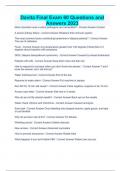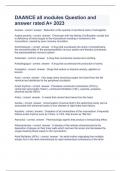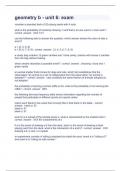Paper Summaries – Survey Research Methods
TABLE OF CONTENT
WEEK 2 – LECTURE 1
• Gallo, A. (2015). A refresher on regression analysis. HBR Online.
• Herhausen, D., Kleinlercher, K., Verhoef, P. C., Emrich, O., & Rudolph, T. (2019).
Loyalty formaTon for different customer journey segments. Journal of Retailing,
95(3), 9-29.
WEEK 3 – LECTURE 1
• Churchill Jr, G. A. (1979). A paradigm for developing be\er measures of markeTng
constructs. Journal of MarkeTng Research, 16(1), 64-73.
• De Luca, L. M., Herhausen, D., Troilo, G., & Rossi, A. (2021). How and when do big
data investments pay off? The role of markeTng affordances and service innovaTon.
Journal of the Academy of MarkeTng Science, 49(4), 790-810.
WEEK 4 – LECTURE 1
• Hulland, J., & Miller, J. (2018). “Keep on Turkin’”? Journal of the Academy of
MarkeTng Science, 46(5), 789-794.
WEEK 4 – LECTURE 2
• Herhausen, D., De Luca, L. M., & Weibel, M. (2018). The interplay between
employee and firm customer orientaTon: SubsTtuTon effect and the conTngency
role of performance- related rewards. BriTsh Journal of Management, 29(3), 534-
553.
• Vomberg, A., & Klarmann, M. (2021). Crahing Survey Research: A SystemaTc Process
for ConducTng Survey Research. In: Handbook of Market Research. Springer. (pp. 3-
23)
WEEK 5 – LECTURE 1
• Gallo, A. (2016). A refresher on A/B tesTng. HBR Online.
• Gallo, A. (2016). A refresher on randomized controlled experiments. HBR Online.
WEEK 5 – LECTURE 2
• Herhausen, D., Emrich, O., Grewal, D., Kipfelsberger, P., & Schoegel, M. (2020). Face
forward: How employees’ digital presence on service websites affects customer
percepTons of website and employee service quality. Journal of MarkeTng Research,
57(5), 917-936.
WEEK 6 – LECTURE 1
• Vomberg, A., & Klarmann, M. (2021). Crahing Survey Research: A SystemaTc Process
for ConducTng Survey Research. In: Handbook of Market Research. Springer. (pp. 23-
40)
,WEEK 2 – LECTURE 1
• Herhausen, D., Kleinlercher, K., Verhoef, P. C., Emrich, O., & Rudolph, T. (2019).
Loyalty formaTon for different customer journey segments. Journal of Retailing,
95(3), 9-29.
From a mulT-channel perspecTve, channels are defined as customer contact points or the
mediums through which the firm and the customer interact. By emphasizing two-way
interacTon, the domain of channels excludes one-way communicaTon, such as TV or search
engine markeTng. Currently, the definiTon of channels is much broader in scope, and
researchers ohen refer to them as touchpoints. Contrary to channels, touchpoints encompass
all types of one-way or two-way interacTons between customers and firms that involve any
transacTonal or informaTonal exchange, including customer-to-customer interacTons.
We idenTfy five Tme-consistent segments―store-focused shoppers, pragmaTc online
shoppers, extensive online shoppers, mulTple touchpoint shoppers, and online to-offline
shoppers.
The development within this segment suggests that mobile usage will foster a parallel use of
touchpoints rather than leading to a decline in the usage of offline touchpoints.
,We also find further support for the existence of a research shopper segment (Verhoef et al.
2007). InteresTngly, we idenTfy a segment of online-to-offline shoppers that mainly searches
online and always purchases offline, but we do not find a dedicated showrooming segment.
Although surprising, the lack of a showrooming segment is in line with previous segmentaTon
studies (Konus et al. 2008, De Keyser et al. 2015) and recent industry reports (Sopadjieva et al.
2017) that indicate that shoppers far more ohen engage in “reverse showrooming” (i.e.,
webrooming) than in showrooming. Although some mulTple touchpoint shoppers may
engage in showrooming behavior (as indicated by frequent use of the physical store for
searching together with an increase in online purchases and an increase in the usage of
mobile devices), our results indicate that the threat of showrooming in the form of a “free-
riding behavior” may be overrated for mulTchannel retailers. On the contrary, research on
webrooming behavior and retailers’ possibiliTes to steer online shoppers to their physical
stores requires more a\enTon.
Mobile devices are used as a complementary search touchpoint, not definable as a single
segment. Usually when the more alternaTves, the more use of mobile devices. But not as a
replacement for other touchpoints.
While journey saTsfacTon is more important than product saTsfacTon for mulTple
touchpoint shoppers and both are equally important for online-to-offline shoppers, product
saTsfacTon sTll prevails over journey saTsfacTon for store-focused shoppers, pragmaTc
online shoppers, and extensive online shoppers. Importantly, we also included the relaTvely
new construct of customer inspiraTon as an antecedent of loyalty. For customers in the
mulTple touchpoint and online-to-offline segments, customer inspiraTon explains customer
loyalty in addiTon to product and journey saTsfacTon. Importantly, customer inspiraTon is
also posiTvely related to loyalty for the store-focused segment, which emphasizes the need
for physical stores to inspire customers.
Herhausen et. Al (2019)
Segment consumers, by survey quesTons about what touchpoints are the most important for
us.
ObjecTves:
• IdenTfy customer segments based on the touchpoints used in the customer journey
• Understand how the increasing importance of mobile devices affects these customer
segments
• Understand the relaTonships between product saTsfacTon, journey saTsfacTon,
customer inspiraTon, and customer loyalty vary across the different segments.
, Framework:
Touchpoints across segments
- General trend: number of touchpoint that a consumer would use.
- Store-focused segment: just go to the store, browse and buy.
- Touchpoints: reviews, email, social media, went to search, got a search ad.
Mobile use across segments
- Mobile is gepng more important. Most in online and mulTple touchpoints. Retailer should
be aware when designing their strategies.
TABLE OF CONTENT
WEEK 2 – LECTURE 1
• Gallo, A. (2015). A refresher on regression analysis. HBR Online.
• Herhausen, D., Kleinlercher, K., Verhoef, P. C., Emrich, O., & Rudolph, T. (2019).
Loyalty formaTon for different customer journey segments. Journal of Retailing,
95(3), 9-29.
WEEK 3 – LECTURE 1
• Churchill Jr, G. A. (1979). A paradigm for developing be\er measures of markeTng
constructs. Journal of MarkeTng Research, 16(1), 64-73.
• De Luca, L. M., Herhausen, D., Troilo, G., & Rossi, A. (2021). How and when do big
data investments pay off? The role of markeTng affordances and service innovaTon.
Journal of the Academy of MarkeTng Science, 49(4), 790-810.
WEEK 4 – LECTURE 1
• Hulland, J., & Miller, J. (2018). “Keep on Turkin’”? Journal of the Academy of
MarkeTng Science, 46(5), 789-794.
WEEK 4 – LECTURE 2
• Herhausen, D., De Luca, L. M., & Weibel, M. (2018). The interplay between
employee and firm customer orientaTon: SubsTtuTon effect and the conTngency
role of performance- related rewards. BriTsh Journal of Management, 29(3), 534-
553.
• Vomberg, A., & Klarmann, M. (2021). Crahing Survey Research: A SystemaTc Process
for ConducTng Survey Research. In: Handbook of Market Research. Springer. (pp. 3-
23)
WEEK 5 – LECTURE 1
• Gallo, A. (2016). A refresher on A/B tesTng. HBR Online.
• Gallo, A. (2016). A refresher on randomized controlled experiments. HBR Online.
WEEK 5 – LECTURE 2
• Herhausen, D., Emrich, O., Grewal, D., Kipfelsberger, P., & Schoegel, M. (2020). Face
forward: How employees’ digital presence on service websites affects customer
percepTons of website and employee service quality. Journal of MarkeTng Research,
57(5), 917-936.
WEEK 6 – LECTURE 1
• Vomberg, A., & Klarmann, M. (2021). Crahing Survey Research: A SystemaTc Process
for ConducTng Survey Research. In: Handbook of Market Research. Springer. (pp. 23-
40)
,WEEK 2 – LECTURE 1
• Herhausen, D., Kleinlercher, K., Verhoef, P. C., Emrich, O., & Rudolph, T. (2019).
Loyalty formaTon for different customer journey segments. Journal of Retailing,
95(3), 9-29.
From a mulT-channel perspecTve, channels are defined as customer contact points or the
mediums through which the firm and the customer interact. By emphasizing two-way
interacTon, the domain of channels excludes one-way communicaTon, such as TV or search
engine markeTng. Currently, the definiTon of channels is much broader in scope, and
researchers ohen refer to them as touchpoints. Contrary to channels, touchpoints encompass
all types of one-way or two-way interacTons between customers and firms that involve any
transacTonal or informaTonal exchange, including customer-to-customer interacTons.
We idenTfy five Tme-consistent segments―store-focused shoppers, pragmaTc online
shoppers, extensive online shoppers, mulTple touchpoint shoppers, and online to-offline
shoppers.
The development within this segment suggests that mobile usage will foster a parallel use of
touchpoints rather than leading to a decline in the usage of offline touchpoints.
,We also find further support for the existence of a research shopper segment (Verhoef et al.
2007). InteresTngly, we idenTfy a segment of online-to-offline shoppers that mainly searches
online and always purchases offline, but we do not find a dedicated showrooming segment.
Although surprising, the lack of a showrooming segment is in line with previous segmentaTon
studies (Konus et al. 2008, De Keyser et al. 2015) and recent industry reports (Sopadjieva et al.
2017) that indicate that shoppers far more ohen engage in “reverse showrooming” (i.e.,
webrooming) than in showrooming. Although some mulTple touchpoint shoppers may
engage in showrooming behavior (as indicated by frequent use of the physical store for
searching together with an increase in online purchases and an increase in the usage of
mobile devices), our results indicate that the threat of showrooming in the form of a “free-
riding behavior” may be overrated for mulTchannel retailers. On the contrary, research on
webrooming behavior and retailers’ possibiliTes to steer online shoppers to their physical
stores requires more a\enTon.
Mobile devices are used as a complementary search touchpoint, not definable as a single
segment. Usually when the more alternaTves, the more use of mobile devices. But not as a
replacement for other touchpoints.
While journey saTsfacTon is more important than product saTsfacTon for mulTple
touchpoint shoppers and both are equally important for online-to-offline shoppers, product
saTsfacTon sTll prevails over journey saTsfacTon for store-focused shoppers, pragmaTc
online shoppers, and extensive online shoppers. Importantly, we also included the relaTvely
new construct of customer inspiraTon as an antecedent of loyalty. For customers in the
mulTple touchpoint and online-to-offline segments, customer inspiraTon explains customer
loyalty in addiTon to product and journey saTsfacTon. Importantly, customer inspiraTon is
also posiTvely related to loyalty for the store-focused segment, which emphasizes the need
for physical stores to inspire customers.
Herhausen et. Al (2019)
Segment consumers, by survey quesTons about what touchpoints are the most important for
us.
ObjecTves:
• IdenTfy customer segments based on the touchpoints used in the customer journey
• Understand how the increasing importance of mobile devices affects these customer
segments
• Understand the relaTonships between product saTsfacTon, journey saTsfacTon,
customer inspiraTon, and customer loyalty vary across the different segments.
, Framework:
Touchpoints across segments
- General trend: number of touchpoint that a consumer would use.
- Store-focused segment: just go to the store, browse and buy.
- Touchpoints: reviews, email, social media, went to search, got a search ad.
Mobile use across segments
- Mobile is gepng more important. Most in online and mulTple touchpoints. Retailer should
be aware when designing their strategies.










